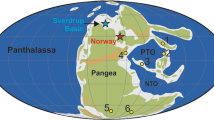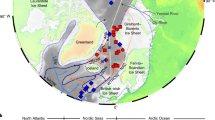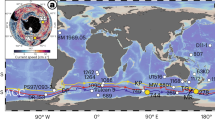Abstract
The onset of the North Atlantic Deep Water formation is thought to have coincided with Antarctic ice-sheet growth about 34 million years ago (Ma). However, this timing is debated, in part due to questions over the geochemical signature of the ancient Northern Component Water (NCW) formed in the deep North Atlantic. Here we present detailed geochemical records from North Atlantic sediment cores located close to sites of deep-water formation. We find that prior to 36 Ma, the northwestern Atlantic was stratified, with nutrient-rich, low-salinity bottom waters. This restricted basin transitioned into a conduit for NCW that began flowing southwards approximately one million years before the initial Antarctic glaciation. The probable trigger was tectonic adjustments in subarctic seas that enabled an increased exchange across the Greenland–Scotland Ridge. The increasing surface salinity and density strengthened the production of NCW. The late Eocene deep-water mass differed in its carbon isotopic signature from modern values as a result of the leakage of fossil carbon from the Arctic Ocean. Export of this nutrient-laden water provided a transient pulse of CO2 to the Earth system, which perhaps caused short-term warming, whereas the long-term effect of enhanced NCW formation was a greater northward heat transport that cooled Antarctica.
This is a preview of subscription content, access via your institution
Access options
Access Nature and 54 other Nature Portfolio journals
Get Nature+, our best-value online-access subscription
$29.99 / 30 days
cancel any time
Subscribe to this journal
Receive 12 print issues and online access
$259.00 per year
only $21.58 per issue
Buy this article
- Purchase on Springer Link
- Instant access to full article PDF
Prices may be subject to local taxes which are calculated during checkout




Similar content being viewed by others
References
Broecker, W. S. Paleocean circulation during the last deglaciation: a bipolar seesaw? Paleoceanography13, 119–121 (1998).
de Boer, A. M., Toggweiler, J. R. & Sigman, D. M. Atlantic dominance of the meridional overturning circulation. J. Phys. Oceano.38, 435–450 (2008).
Toggweiler, R. & Samuels, B. Effect of Drake Passage on the global thermohaline circulation. Deep Sea Res. I42, 477–500 (1995).
Abelson, M. & Erez, J. The onset of modern-like Atlantic meridional overturning circulation at the Eocene–Oligocene transition: evidence, causes, and possible implications for global cooling. Geochem. Geophys. Geosystems18, 2177–2199 (2017).
Cramer, B. S., Toggweiler, J. R. T., Wright, J. D., Katz, M. E. & Miller, G. H. Ocean overturning since the Late Cretaceous: inferences from a new benthic foraminiferal isotope compilation. Paleoceanography24, PA4216 (2009).
Davies, R., Cartwright, J., Pike, J. & Line, C. Early Oligocene initiation of North Atlantic Deep Water formation. Nature410, 917–920 (2001).
Egloff, J. & Johnson, G. L. Morphology and structure of the Southern Labrador Sea. Can. J. Earth Sci.12, 2111–2133 (1975).
Miller, K. G. & Tucholke, B. E. in Structure and Development of the Greenland–Scotland Ridge (eds Bott, M. H. P., Thiede, J., Saxov, S. & Talwani, M.) 549–589 (Plenum, New York, 1983).
Via, R. K. & Thomas, D. J. Evolution of Atlantic thermohaline circulation: early Oligocene onset of deep-water production in the North Atlantic. Geology34, 441–444 (2006).
Borrelli, C., Cramer, B. S. & Katz, M. E. Bipolar Atlantic deepwater circulation in the middle–late Eocene: effects of Southern Ocean gateway openings. Paleoceanography29, 308–327 (2014).
Boyle, P. R. et al. Cenozoic North Atlantic deep circulation history recorded in contourite drifts, offshore Newfoundland, Canada. Mar. Geol.385, 185–203 (2017).
Hohbein, M. W., Sexton, P. F. & Cartwright, J. A. Onset of North Atlantic Deep Water production coincident with inception of the Cenozoic global cooling trend. Geology40, 255–258 (2012).
Langton, S. J., Rabideaux, N. M., Borrelli, C. & Katz, M. E. Southeastern Atlantic deep-water evolution during the late–middle Eocene to earliest Oligocene (Ocean Drilling Program Site 1263 and Deep Sea Drilling Project Site 366). Geosphere12, 1032–1047 (2016).
Wright, J. D. & Miller, K. G. Control of North Atlantic Deep Water circulation by the Greenland–Scotland Ridge. Paleoceanography11, 157–170 (1996).
Sijp, W. P., England, M. H. & Huber, M. Effect of the deepening of the Tasman Gateway on the global ocean. Paleoceanography26, PA4207 (2011).
Elsworth, G., Galbraith, E., Halverson, G. & Yang, S. Enhanced weathering and CO2 drawdown caused by latest Eocene strengthening of the Atlantic meridional overturning circulation. Nat. Geosci.10, 213–216 (2017).
Tigchelaar, M., von der Heydt, A. S. & Dijkstra, H. A. A new mechanism for the two-step δ18O signal at the Eocene–Oligocene boundary. Clim. Past.7, 235–247 (2010).
Zhang, Z. et al. Tropical seaways played a more important role than high latitude seaways in Cenozoic cooling. Clim. Past.7, 801–813 (2011).
Huber, M. & Sloan, L. C. Heat transport, deep waters, and thermal gradients: coupled simulation of an Eocene greenhouse climate. Geophys. Res. Lett.28, 3481–3484 (2001).
Pusz, A. E., Thunell, R. C. & Miller, K. G. Deep water temperature, carbonate ion, and ice volume changes across the Eocene–Oligocene climate transition. Paleoceanography26, PA2205 (2011).
Firth, J. V., Eldrett, J. S., Harding, I. C., Coxall, H. K. & Wade, B. Integrated biomagnetochronology for the Palaeogene of ODP Hole 647A: implications for correlating palaeoceanographic events from high to low latitudes. Geol. Soc. Spec. Pub.373, 29–78 (2013).
Coxall, H. K. & Wilson, P. A. Early Oligocene glaciation and productivity in the eastern equatorial Pacific; insights into global carbon cycling. Paleoceanography26, PA2221 (2011).
Kroopnick, P. The distribution of 13C of ∑CO2 in the world oceans. Deep Sea Res.32, 57–84 (1985).
Golovneva, L. B. Early Palaeogene floras of Spitsbergen and North Atlantic floristic exchange. Acta Univ. Carol. Geol.44, 39–50 (2000).
Akhmetiev, M. A. & Beniamovski, V. N. Paleogene floral assemblages around epicontinental seas and straits in Northern Central Eurasia: proxies for climatic and paleogeographic evolution. Geol. Acta7, 297–309 (2009).
Gleason, J. D. et al. Early to middle Eocene history of the Arctic Ocean from Nd–Sr isotopes in fossil fish debris, Lomonosov Ridge. Paleoceanography24, PA2215 (2009).
O’Regan, A. M., Williams, C. J., Frey, K. E. & Jakobsson, M. A synthesis of the long-term paleoclimatic evolution of the Arctic. Oceanography24, 66–80 (2011).
Pusz, A. E. et al. Stable isotopic response to late Eocene extraterrestrial impacts. Geol. Soc. Am. Special Papers452, 83–95 (2009).
Arthur, M. A. et al. inProc. Ocean Drilling Program Scientific Results Vol. 105 (eds Srivastava, S. P. et al.) 111–135 (Ocean Drilling Program, 1989).
Nielsen, S. B. et al. The evolution of western Scandinavian topography: a review of Neogene uplift versus the ICE (isostasy–climate–erosion) hypothesis. J. Geodynam.47, 72–95 (2009).
Lear, C. H., Bailey, T. R., Pearson, P. N. P., Coxall, H. K. & Rosenthal, Y. Cooling and ice growth across the Eocene–Oligocene transition.Geology36, 251–254 (2008).
Liu, L. et al. Global cooling during the Eocene–Oligocene climate transition. Science323, 1187–1190 (2009).
Waddell, L M. & Moore, T. C. Salinity of the Eocene Arctic Ocean from oxygen isotope analysis of fish bone carbonate. Paleoceanography23, PA1S12 (2008).
Stärz, M., Jokat, W., Knorr, G. & Lohmann, G. Threshold in North Atlantic–Arctic Ocean circulation controlled by the subsidence of the Greenland–Scotland Ridge. Nat. Commun.8, 15681 (2017).
Roberts, C. D., LeGrande, A. N. & Tripati, A. K. Climate sensitivity to Arctic seaway restriction during the early Paleogene. Earth Planet. Sci. Lett.286, 576–585 (2009).
Brinkhuis, H. et al. Episodic fresh surface waters in the Eocene Arctic Ocean. Nature441, 606–609 (2006).
Kaminski, M. & Ortiz, S. The Eocene–Oligocene turnover of deep-water agglutinated foraminifera at ODP Site 647, Southern Labrador Sea (North Atlantic). Micropaleontology60, 53–66 (2014).
Burton, K. W., Ling, H. F. & O’Nions, R. K. Closure of the Central American isthmus and its effect on deep-water formation in the North Atlantic. Nature386, 382–385 (1997).
O’Nions, R. K., Frank, M., von Blanckenburg, F. & Ling, H. F. Secular variation of Nd and Pb isotopes in ferromanganese crusts from the Atlantic, Indian and Pacific Oceans. Earth Planet. Sci. Lett.155, 15–28 (1998).
Scher, H. D. & Martin, E. E. Timing and climatic consequences of the opening of Drake Passage. Science312, 428–430 (2006).
Lambelet, M. et al. Neodymium isotopic composition and concentration in the western North Atlantic Ocean: results from the GEOTRACES GA02 section. Geochem. Cosmochim. Acta177, 1–29 (2016).
Lacan, F. & Jeandel, C. Acquisition of the neodymium isotopic composition of the North Atlantic Deep Water. Geochem. Geophys. Geosystems6, Q1208 (2005).
Porcelli, D. et al. The distribution of neodymium isotopes in Arctic Ocean basins. Geochim. Cosmochim. Acta73, 2645–2659 (2009).
Grandjean, P., Cappetta, H., Michard, A. & Albarede, F. The assessment of REE patterns and 143Nd/144Nd Nd ratios in fish remains. Earth Planet. Sci. Lett.84, 181–196 (1987).
Stille, P. & Fischer, H. Secular variation in the isotopic composition of Nd in Tethys seawater. Geochim. Cosmochim. Acta54, 3139–3145 (1990).
Kharin, G. S. & Lukashina, N. P. Paleogeography of the Norwegian–Greenland and northwestern European Sea basins in the Paleogene.Oceanology50, 226–239 (2010).
Musatov, E. E. & Pogrebitskij, Y. E. Late Mesozoic–Cenozoic evolution of the Barents Sea and Kara Sea continental margins. Polarforschung68, 283–290 (2000).
Andreasson, F. P., Schmitz, B. & Spiegler, D. Stable isotopic composition (delta18OCO3 2–, delta13C) of early Eocene fish-apatite from Hole 913B: an indicator of the early Norwegian–Greenland Sea paleosalinity. InProc. Ocean Drilling Program Sci. Res. Vol. 151 (eds Thiede, J. et al.) 583–591 (Ocean Drilling Program, 1996).
Hegewald, A. & Jokat, W. Relative sea level variations in the Chukchi region — Arctic Ocean — since the late Eocene.Geophys. Res. Lett.40, 2013 (2013).
Anagnostou, E. et al. Changing atmospheric CO2 concentration was the primary driver of early Cenozoic climate. Nature533, 380–384 (2016).
Schmitz, W. J. & McCartney, M. S. On the North Atlantic Circulation. Rev. Geophys.31, 29–49 (1993).
Laughton, A. S. et al. Shipboard reports of Sites 112, 118 and 119. In Initial Rep. Deep Sea Dril. Project Vol. 12 (eds Laughton, A. S. et al.) 161–253 (US Government Printing Office, Washington, 1972).
Norris, R. D. et al. In Proc. Integrated Ocean Drilling Program Vol. 342 (Integrated Ocean Drilling Program, 2014).
Miller, K. G. & Katz, M. E. Eocene benthic foraminiferal biofacies of the New Jersey Transect. In Initial Rep. Deep Sea Drill. Project Vol. 95 (eds Poag, C. W. et al.) 267–298 (US Government Printing Office, Washington, 1987).
Cande, S. C. & Kent, D. V. Revised calibration of the geomagnetic polarity timescale for the Late Cretaceous and Cenozoic. J. Geophys. Res.100, 6093–6095 (1995).
Zachos, J. C., Pagani, M., Sloan, L. C., Thomas, E. & Billups, K. Trends, rhythms, and aberrations in global climate 65 Ma to present.Science292, 686–693 (2001).
Zachos, J. C., Dickens, G. R. & Zeebe, R. E. An early Cenozoic perspective on greenhouse warming and carbon-cycle dynamics. Nature451, 279–283 (2008).
Lear, C. H. et al. Neogene ice volume and ocean temperatures: insights from infaunal foraminiferal Mg/Ca paleothermometry. Paleoceanography30, 1437–1454 (2015).
Pearson, P. N. et al. Warm tropical sea surface temperatures in the Late Cretaceous and Eocene epochs. Nature413, 481–487 (2001).
Katz, M. E. et al. Early Cenozoic benthic foraminiferal isotopes: species reliability and interspecies correction factors. Paleoceanography18, 1024 (2003).
Rathburn, A. E., Corliss, B. H., Tappa, K. D. & Lohmann, K. C. Comparisons of the ecology and stable isotopic compositions of living (stained) benthic foraminifera from the Sulu and South China Seas. Deep Sea Res. I43, 1617–1646 (1996).
Boyle, E. A. Manganese carbonate overgrowths on foraminifera tests.Geochim. Cosmochim. Acta47, 1815–1819 (1983).
Boyle, E. A. & Keigwin, L. D. Comparison of Atlantic and Pacific paleochemical records for the last 215,000 years: changes in deep ocean circulation and chemical inventories. Earth Planet. Sci. Lett.76, 135–150 (1985).
Barker, S., Greaves, M. & Elderfield, H. A study of cleaning procedures used for foraminiferal Mg/Ca paleothermometry. Geochem. Geophys. Geosystems4, 8407 (2003).
Marchitto, T. M. et al. Improved oxygen isotope temperature calibrations for cosmopolitan benthic foraminifera. Geochim. Cosmochim. Acta130, 1–11 (2014).
Mueller-Lupp, T., Erlenkueser, H. & Bauch, H. A. Seasonal and interannual variability of Siberian river discharge in the Laptev Sea inferred from stable isotopes in modern bivalves. Boreas32, 292–303 (2003).
Fairbanks, R. G., Charles, C. D. & Wright, J. D. Radiocarbon After Four Decades 473–500 (Springer, New York, 1992).
Martin, E. E. & Haley, B. A. Fossil fish teeth as proxies for seawater Sr and Nd isotopes. Geochim. Cosmochim. Acta64, 835–847 (2000).
Pin, C. & Zalduegui, J. S. Sequential separation of light rare-earth elements, thorium and uranium by miniaturized extraction chromatography: application to isotopic analyses of silicate rocks. Anal. Chim. Acta339, 79–89 (1997).
Chavagnac, V. et al. Towards the development of a fossil bone geochemical standard: an inter-laboratory study. Anal. Chim. Acta599, 177–190 (2007).
Scher, H. D. & Delaney, M. L. Breaking the glass ceiling for high resolution Nd isotope records in early Cenozoic paleoceanography. Chem. Geol.269, 329–338 (2010).
Thomas, D. J., Bralower, T. J. & Jones, C. E. Neodymium isotopic reconstruction of late Paleocene–early Eocene thermohaline circulation.Earth Planet. Sci. Lett.209, 309–322 (2003).
Martin, E. E. & Scher, H. A Nd isotopic study of southern sourced waters and Indonesian throughflow at intermediate depths in the Cenozoic Indian Ocean. Geochem. Geophys. Geosystems7, Q09N02 (2006).
Moiroud, M. et al. Evolution of the neodymium isotopic signature of neritic seawater on a northwestern Pacific margin: new constrains on possible end-members for the composition of deep-water masses in the Late Cretaceous ocean. Chem. Geol.356, 160–170 (2013).
Baatsen, M. et al. A generalised approach to reconstructing geographical boundary conditions for palaeoclimate modelling. Clim. Past.12, 4917–4942 (2016).
Acknowledgements
Samples were provided by the International Ocean Discovery Program (IODP), which includes the predecessors the International Ocean Drilling Program (IODP), Deep Sea Drilling Project (DSDP) and Ocean Drilling Program (ODP). We thank J. Becker and M. Spencer for technical assistance with the stable isotopes, and H. Öste and E. Axelsson for preparing the core samples. H.K.C. was supported by a Royal Society Research Fellowship, Swedish Funding agency (VR) no. DNR 2008-2859 and the Bolin Centre for Climate Research, and T.vdF. by NERC Grants NE/I006257/1 and NE/L004607/1. K.K.S. acknowledges financial support from the Danish Council for Independent Research/Natural Sciences (DFF/FNU; Grant 11-107497).
Author information
Authors and Affiliations
Contributions
H.K.C. and J.B. conceived the project. H.K.C. directed the research, generated the stable isotope data for Sites 112, 647 and U1411, compiled the proxy records and led writing of the paper. A.L.-L. produced the new Site 612 data and age model. C.H.L. conducted the trace metal analysis. C.E.H. produced and interpreted the Nd data with the help of T.vdF. M.O. produced the palaeogeographic map for Fig. 1 and conducted the subsidence modelling. K.K.S. helped produce the Site 647 age model. M.H. helped with the interpretative framework and produced the interpolated Atlantic depth isotopic transects and maps. J.C.Z. and A.M.d.B. helped interpret the data. All of the authors contributed to writing the manuscript.
Corresponding author
Ethics declarations
Competing interests
The authors declare no competing interests.
Additional information
Publisher’s note: Springer Nature remains neutral with regard to jurisdictional claims in published maps and institutional affiliations.
Supplementary information
Supplementary Information
Supplementary discussion and figures
Supplementary Data 1
Stable isotope data
Supplementary Data 2
Trace-metal data and palaeotemperatures
Rights and permissions
About this article
Cite this article
Coxall, H.K., Huck, C.E., Huber, M. et al. Export of nutrient rich Northern Component Water preceded early Oligocene Antarctic glaciation. Nature Geosci 11, 190–196 (2018). https://doi.org/10.1038/s41561-018-0069-9
Received:
Accepted:
Published:
Issue Date:
DOI: https://doi.org/10.1038/s41561-018-0069-9
This article is cited by
-
Oxygenated deep waters fed early Atlantic overturning circulation upon Antarctic glaciation
Nature Geoscience (2023)
-
Large obliquity-paced Antarctic ice-volume fluctuations suggest melting by atmospheric and ocean warming during late Oligocene
Communications Earth & Environment (2023)
-
Deep-sea benthic foraminiferal response to the early Oligocene cooling: a study from the Southern Ocean ODP Hole 1138A
Geo-Marine Letters (2023)
-
Eocene to Oligocene terrestrial Southern Hemisphere cooling caused by declining pCO2
Nature Geoscience (2021)
-
Orbital climate variability on the northeastern Tibetan Plateau across the Eocene–Oligocene transition
Nature Communications (2020)



